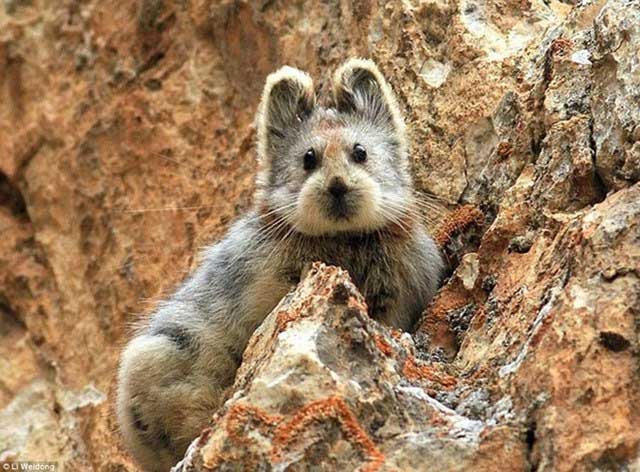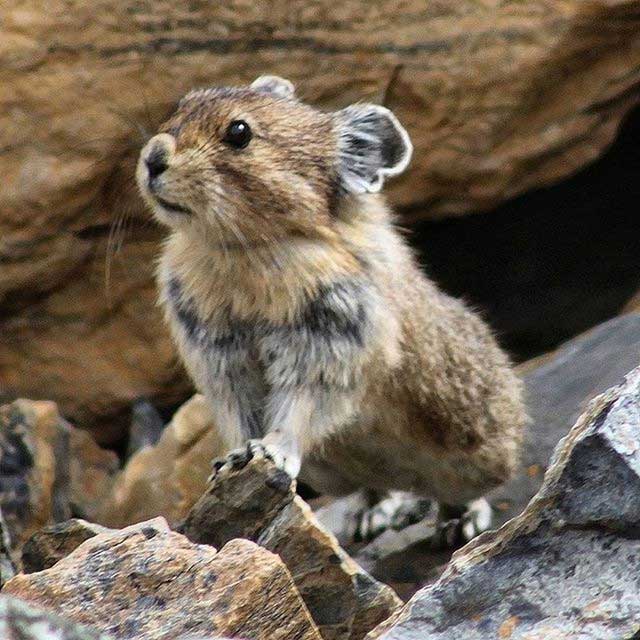Reappearing after more than 20 years of disappearance, the animal immediately caused a stir because it was rarer than the panda.
After being discovered in 1983 and seen again in 1990, the animal disappeared without a trace for more than 20 years .
In today's world, there are many animals that we have not discovered or have never heard of. And there are also animals that people have only heard of and then they disappear without a trace. The Ili Pika is no exception. It was not until more than 2 decades later that scientists had the opportunity to photograph this animal.

Ili pika rabbit reappears after more than 20 years of disappearance. (Photo: CNN)
With fewer than 1,000 individuals remaining, the Ili pika is one of the world's most endangered species. It is even considered rarer than the panda .
The Ili Pika is a species of mammal in the family Ochotona of the order Lagodon, endemic to northwestern China. It lives in the Tianshan Mountains of Xinjiang, China. It is also found in the northwestern United States and western Canada.

Ili pika rabbits live at altitudes of 2,800 to 4,000 meters. (Photo: CNN)
Ili pika is only found at an altitude of 2,800 - 4,000 meters . Ili pika rabbits are about 20cm long, weigh about 180 grams and have large ears. They have gray-brown fur, short limbs with round ears that look very cute, and a bear-like face. At first glance, Ili pika rabbits look as adorable as teddy bears. Their food is mainly grass growing around. Ili Pika rabbits' enemies are foxes, weasels, birds of prey, etc.
Ili pika rabbits often forage for food in the summer. They will use the entire time during this warm period to store food for the cold winter. According to statistics from scientists, an Ili pika rabbit will make 10,000 trips in the summer to accumulate 25 kg of food.

They often forage in the summer to store up for the cold winter. (Photo: CNN)
However, there are many Ili pika rabbits who "do nothing" by "stealing" food from other rabbits. Because of this strange habit, they have another nickname: "cute thieves".
The Ili pika was discovered by Mr. Ly Duy Dong in 1983. He later decided to name it after his hometown, Ili. Mr. Ly recalled the first time he encountered an Ili pika: "I climbed a mountain for 4 hours. I stopped to catch my breath, and suddenly I saw the shadow of a tiny creature running past. I sat down on some rocks, and a pair of rabbit ears poked out from the cracks in the rocks nearby. The little animal was looking at me and blinking. I thought this was the most beautiful and strange animal I had ever seen. I couldn't believe my eyes . "

However, there are many "lazy" Ili pika rabbits that steal other rabbits' food to make it their own. (Photo: CNN)
Scientists have taken a census of the Ili pika, and they estimate that the Ili pika population has dropped from 2,900 in the 1990s to 2,000 in 2005. There are probably only about 1,000 left now. According to scientists, since they were discovered, the population of this species has decreased by 70%.
"Small animals can become extinct at any time. They will no longer exist in the places where they used to live ," Mr. Ly shared with CNN.
Ili pikas used to live at altitudes of around 3,200-3,400 m, but they have now climbed to as high as 4,100 m. In 2008, the International Union for Conservation of Nature (IUCN) classified them as endangered , but no organization or expert group has attempted to study or protect them.

The Ili pika rabbit is at risk of extinction due to climate change and humans. (Photo: CNN)
Global air pollution, climate change and increased grazing pressure are considered the main threats to the species. Another reason is the over-presence of humans in the foothills, which has gradually reduced their habitat.
- 'Dragon ice dragon' - super rare natural phenomenon appears in Antarctica after 10 years of disappearance
- Why can stir fry a dish that can be harmful to health?
- Catching super rare purple crabs caused a stir
- Mysterious disappearance: Pretending to die for 20 years to leave the country, getting a new wife because of bored ex-wife
- Penguins get lost in New Zealand
- Reappearing extinct salmon species 70 years ago
- Wild animals died of H5N1 in Cuc Phuong
- Decode the disappearance of leprosy in Europe
- Seeing the goat walking on two legs, the owner took out his phone to record, what happened next caused shivers
- The man had to have his arm amputated by a shrimp to save his life
- Human ancestors caused the extinction of animals 4 million years ago
- The appearance of unicorns caused a stir because it was too different
 Animal 'suffering' after hibernation
Animal 'suffering' after hibernation Why do goats climb well?
Why do goats climb well? Scientists were surprised to see chimpanzees eating turtles
Scientists were surprised to see chimpanzees eating turtles Giant catfish died deadly due to drought in Thailand
Giant catfish died deadly due to drought in Thailand